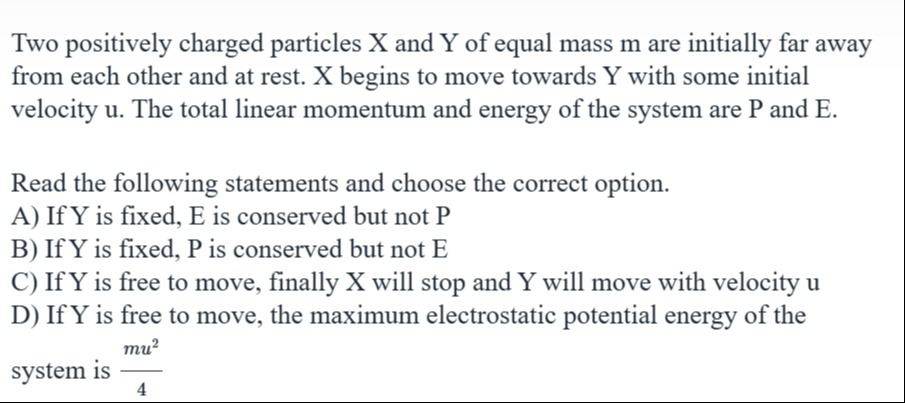Question
Question: Two positively charged particles X and Y of equal mass m are initially far away from each other and ...
Two positively charged particles X and Y of equal mass m are initially far away from each other and at rest. X begins to move towards Y with some initial velocity u. The total linear momentum and energy of the system are P and E.

A
If Y is fixed, E is conserved but not P
B
If Y is fixed, P is conserved but not E
C
If Y is free to move, finally X will stop and Y will move with velocity u
D
If Y is free to move, the maximum electrostatic potential energy of the system is 4mu2
Answer
A, C, D
Explanation
Solution
- Statement A: If Y is fixed, an external force acts on the system to keep Y stationary. This external force means the total linear momentum (P) of the system is not conserved. However, if the force holding Y fixed does no work (i.e., Y has zero displacement), the total mechanical energy (E) of the system (kinetic energy of X + potential energy) is conserved. Thus, A is correct.
- Statement B: This is the opposite of statement A. Since P is not conserved when Y is fixed, B is incorrect.
- Statement C: If Y is free to move, the interaction is governed by conservation of momentum and energy. Since the electrostatic force is conservative, the interaction is elastic. For an elastic collision between two particles of equal mass where one is initially at rest, the particles exchange velocities. If X has initial velocity u and Y is at rest, after a head-on collision, X will stop (vx=0) and Y will move with velocity u (vy=u). Thus, C is correct.
- Statement D: When Y is free to move, the maximum electrostatic potential energy (Umax) occurs at the point of closest approach. At this point, the relative velocity between X and Y is zero, meaning they have the same velocity. From conservation of momentum (mvx+mvy=mu) and vx=vy, we get vx=vy=u/2. The kinetic energy at this point is Kclosest=21m(u/2)2+21m(u/2)2=4mu2. By conservation of total energy (E=21mu2), we have E=Kclosest+Umax. Therefore, 21mu2=4mu2+Umax, which gives Umax=4mu2. Thus, D is correct.
